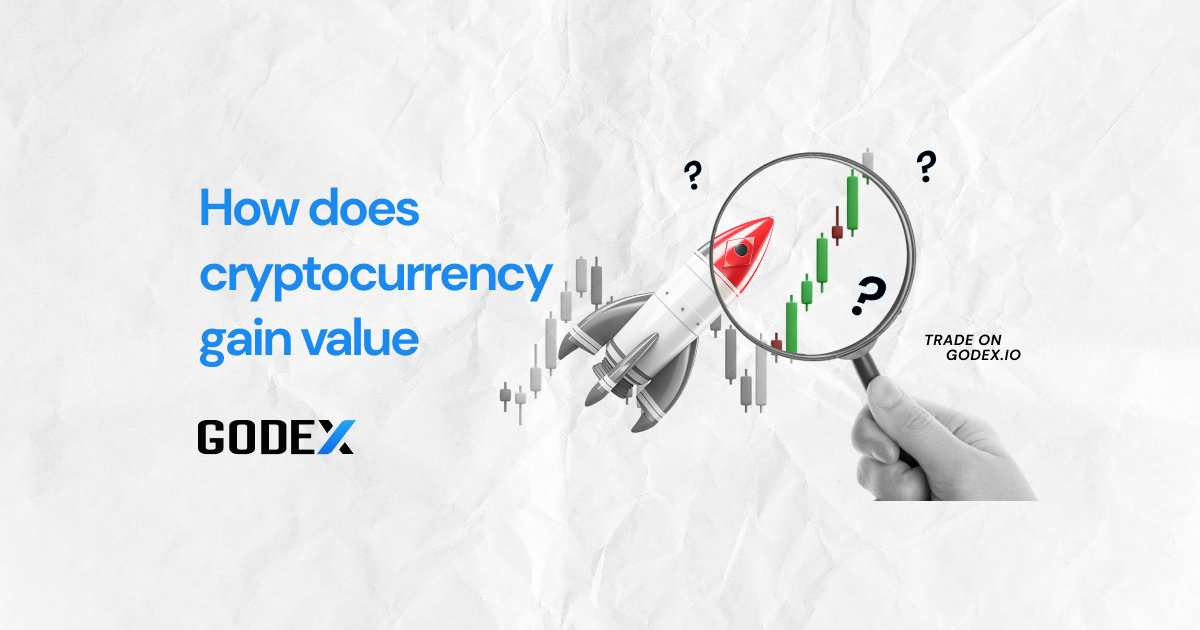Table of Contents
In a digital cosmos where a meme-inspired coin can skyrocket to the moon while established projects struggle for recognition, the enigma of cryptocurrency valuation looms large. Picture this: one token buys you a seat in a Tesla, while another barely covers your morning coffee. What mystic forces govern this peculiar economy, where value fluctuates like the tides? As digital currencies dance between the realms of fortune and oblivion, the question persists: What alchemy transforms lines of code into tangible wealth? Or in other words: How does cryptocurrency gain value?
In this exploration, we embark on a journey through the intricate pathways that sculpt the worth of cryptocurrencies. From the whims of speculative frenzy to the bedrock of technological innovation, we unravel the enigmatic forces shaping the fate of digital assets.
The Concept of Cryptocurrency
Nowadays it’s difficult to find a person who doesn’t know anything about cryptocurrency and couldn’t at least explain in general what it is. But not everyone understands the depth and importance of this intangible monetary miracle. Imagine a world where money isn’t minted in steel and paper but woven into the very fabric of the internet—an invisible currency traversing digital highways, unbound by borders or banks. This is the essence of cryptocurrency, a revolutionary concept that defies the traditional notion of money. At its core, crypto is a decentralized form of currency, existing solely in digital form and secured by cryptography. Instead of relying on central authorities like governments or financial institutions, cryptocurrencies operate on a peer-to-peer network, where transactions are verified and recorded by a decentralized ledger known as the blockchain. In this realm, trust is not placed in institutions but in the transparency and integrity of mathematical algorithms. Cryptocurrencies offer not just a new way to exchange value but a philosophy—a belief in democratizing finance, empowering individuals, and challenging the status quo of monetary systems. In essence, crypto is more than just digital cash; it’s a symbol of a decentralized future, where financial sovereignty belongs to the people.
Understanding Cryptocurrency
To truly grasp the essence of cryptocurrency, one must delve into its intricate workings and multifaceted nature. Unlike common fiat currencies, which rely on centralized authorities, cryptocurrencies operate on decentralized networks, powered by cutting-edge blockchain technology. This decentralization ensures transparency, security, and immutability—a stark departure from the opaque processes of conventional finance. Moreover, the crypto landscape boasts a diverse array of digital assets, from the pioneering Bitcoin to innovative altcoins and tokens, each with its own unique features and utilities. However, what truly sets cryptocurrency apart is its volatile pricing dynamics, where values can surge or plummet in a matter of hours. Comprehending the mechanisms driving this volatility is decisive for traders and investors alike, as they navigate the ever-evolving landscape of digital finance. So, how does cryptocurrency value increase? Stay tuned to find out.
Factors Influencing Cryptocurrency Value
Crypto value is influenced by a myriad of factors, reflecting its complex nature and the interplay of various market dynamics. These factors can broadly be categorized into technological, economic, regulatory, and sentiment-driven elements.
Technological Advancements
Innovations within the crypto space, such as the development of new consensus algorithms, scalability solutions, security enhancements, and interoperability protocols, can significantly impact the value of cryptocurrencies. Projects that demonstrate technological superiority or solve pressing industry challenges often attract investor attention and drive up demand, consequently influencing prices.
Market Dynamics
Crypto valuation adheres to fundamental economic laws of supply and demand, akin to traditional assets. Various factors including user uptake, trading activity, market liquidity, and token dispersal contribute to the delicate balance between buyers and sellers, thereby exerting pressure on prices. The concept of scarcity, exemplified by Bitcoin’s finite supply limit, emerges as a pivotal driver in shaping long-term value trajectories within the crypto sphere.
Utility
Cryptocurrencies derive value from their utility, enabling users to perform specific actions within a blockchain ecosystem. Take Ethereum, for instance, offering access to decentralized apps and non-fungible tokens (NFTs), thereby enhancing demand.
Competition
Cryptocurrencies operate in a competitive landscape, where the emergence of alternative projects can diminish demand for existing ones. Before the Ethereum Merge, rival blockchains lured users with promises of lower fees and faster transactions, exerting pressure on Ethereum’s market share.
Regulatory Landscape
The changing regulatory environment and governmental stances wield considerable influence over cryptocurrency markets. The presence of clear guidelines or lingering uncertainties regarding the legal, tax, and compliance aspects of digital assets can sway investor confidence and shape market behavior. Whether through stringent enforcement actions, outright bans, or frameworks supportive of innovation, regulatory shifts can trigger notable price swings as market players recalibrate their approaches in response.
Market Sentiment
Investor sentiment significantly impacts crypto prices. Positive market sentiment, often catalyzed by significant events like IPOs or endorsements, can propel prices upwards, as seen with Bitcoin following the Coinbase IPO.
Macroeconomic Factors
Crypto markets are not isolated from broader economic trends and geopolitical events. Factors such as inflation, monetary policy decisions, currency devaluation, geopolitical tensions, and macroeconomic indicators can influence investor risk appetite and capital flows into cryptocurrencies as alternative assets or safe-haven investments.
Tokenomics
Tokenomics, encompassing a crypto project’s supply and demand dynamics, dictates its value trajectory. Factors such as fixed supply limits, burning mechanisms, and token vesting schedules influence scarcity and demand dynamics, impacting price appreciation.
Technological Risks and Security Concerns
Blockchain protocols, smart contracts, and exchanges can have vulnerabilities. These weaknesses can shake investor confidence and cause prices to drop. High-profile hacks, security breaches, or technical flaws can damage trust and slow adoption. This affects the value of affected cryptocurrencies and overall market sentiment.
Manipulative Tactics in Markets
Crypto markets, being emergent and loosely regulated, are prone to manipulation. Whales, pump-and-dump schemes, and other deceptive practices can distort market fundamentals and mislead investors. This leads to artificial price movements that may not reflect the true value of assets.
Ways to Predict Cryptocurrency Value
Predicting cryptocurrency value is notoriously challenging due to the volatility and complexity of these markets. However, several strategies can help investors make more informed decisions:
- Fundamental Analysis:
Fundamental analysis assesses what influences cryptocurrency value, like technology, adoption, and market trends. By researching thoroughly, investors can find undervalued assets poised for growth.
- Technical Analysis:
Technical analysis relies on statistical trends and chart patterns to forecast future price movements. Traders use tools such as moving averages, relative strength index (RSI), and Fibonacci retracements to identify entry and exit points for trades.
- Sentiment Analysis:
Sentiment analysis involves monitoring social media, news sources, and online forums to gauge market sentiment and investor behavior. By understanding the prevailing sentiment, investors can anticipate market movements and adjust their strategies accordingly.
- Market Dynamics:
Understanding market dynamics, such as supply and demand dynamics, trading volume, and order book depth, can provide valuable insights into cryptocurrency value. Monitoring market indicators and trends can help investors identify emerging opportunities and risks.
Read also How to Calculate Your Crypto Trading Profit?
Profits and Returns in Cryptocurrency
As we have learned, cryptocurrencies are known for their wild price swings and lack of regulatory oversight. This means they can skyrocket without restraint, delivering impressive returns to investors. Getting in on a cryptocurrency’s ground floor, before it becomes well-known, can result in big profits as demand pushes prices up. Stories abound of people turning small investments into fortunes overnight by backing promising projects.
Beyond traditional investing, there are other ways to make money in the crypto space, such as mining and staking. Mining involves validating transactions for a fee, while staking involves locking up crypto as a form of deposit. Both can generate profits for participants.
Investing in crypto can be highly lucrative, but it also carries serious risks. The value of a coin can surge or crash unpredictably. It leaves investors either celebrating or regretting their decisions. To succeed in this unpredictable market, it’s crucial to have a clear plan for spreading your investments and managing risks. Although no plan can fully prevent losses, it can reduce risks and boost profits over time.
FAQ
Are cryptocurrencies impacted by government regulations?
Yes, digital assets are affected by government regulations. Regulations can affect their acceptance and value. Governments might enforce laws on trading, taxation, or even ban them outright. Such regulations often cause fluctuations in coin prices. Investors closely monitor regulatory developments.
What is the utility value of a cryptocurrency?
The utility value of a digital asset hinges on its type. Some cryptocurrencies are used for transactions. Others offer functionality within specific platforms. Each type serves different purposes. Utility determines its practical value.
Is liquidity a crucial factor in cryptocurrency markets?
Absolutely, liquidity is paramount in crypto markets. It ensures smooth trading and price stability. High liquidity means easier buying and selling. Low liquidity can lead to volatile price swings.
Start a Cryptocurrency exchange
Try our crypto exchange platform
Disclaimer: Please keep in mind that the content of this article is not financial or investing advice. The information provided is the author’s opinion only and should not be considered as direct recommendations for trading or investment. Any article reader or website visitor should consider multiple viewpoints and become familiar with all local regulations before cryptocurrency investment. We do not make any warranties about reliability and accuracy of this information.
 Peter Moore
Peter Moore 
Read more
Ripple (XRP) price has been widely discussed by the cryptocurrency community since it has gained public interest in 2017, even though it was founded by Chris Larsen and Jed McCaleb years before. The platform offers innovative blockchain solutions for the banking sector and has the potential to disrupt the whole finance industry. In recent years, […]
In this article we will talk about Ripple (XRP) and its price prediction. What is Ripple (XRP) Ripple is a San Francisco-based startup that was launched in 2012 by Ripple Labs as a global network both for cross-currency and gross payments. Ripple history began in 2004 with the discussions around the digital coin in the […]
You may well think that an article dedicated to a Tether price prediction or the Tether price in general is a little bit strange — it is a stablecoin after all. However, the price of Tether does fluctuate significantly, although it is nowhere near as volatile as non-stablecoin cryptos. This means that staying up to […]
In the article we share our vision at Zcash cryptocurrency main features and add several price predictions. As cryptocurrencies gain global acceptance and decentralisation slowly enters our lives, privacy becomes the main concern when talking about blockchain adoption. It is no secret that distributed ledger is by far the most secure and transparent technology ever […]
Chiliz coin (CHZ) offers a compelling opportunity for traders interested in the intersection of blockchain technology and sports. By enabling fans to influence team decisions through the Socios app, Chiliz directly monetizes fan engagement and connects with major sports teams like Juventus and Paris Saint-Germain. These partnerships not only enhance the platform’s visibility but also […]
The exponential growth of Bitcoin Satoshi Vision (BSV) against the general bear trend on the cryptocurrency market in autumn 2019 has impressed the community. Due to the increasing market capitalization, the newly emerged altcoin was ranked 5th on CoinMarketCap and managed to maintain its high position at the beginning of 2020. In the article we […]